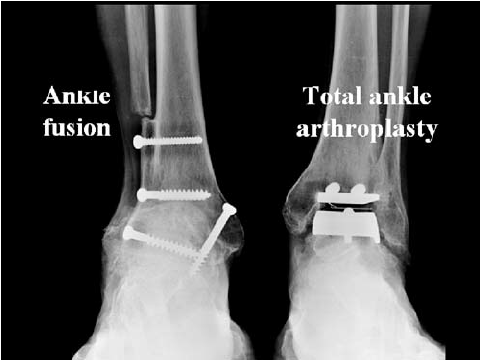Emerging Technology in the Foot and Ankle: Total Ankle Arthroplasty

Ankle arthritis is fundamentally different from hip and knee arthritis; historically, the treatment has been different as well. Ankle arthritis is most frequently post traumatic in nature —usually occurring after a significant fracture or bone trauma. However, we are now finding that multiple episodes of instability, i.e., simple ankle sprains, can lead to the development of debilitating ankle arthritis. The inflammatory arthritides (rheumatoid) can also significantly affect the ankle joint as well. Initial treatment for ankle arthritis is conservative. Physical therapy, NSAIDS, bracing and injections are the mainstays of conservative treatment. Traditionally, treatment for end stage ankle arthritis has been ankle arthrodesis, or fusion. Fusion eliminates motion at the level of the ankle and leads to functional limitations. It essentially eliminates the ankle as a motion segment leads to a limp and loss of function.
A Brief History of Ankle Replacements
Ankle replacements emerged in the 60’s and 70’s. But, they tended to fail quickly, and were not as reliable and long lasting as the total hip and knee replacements available at the time. During the 80’s, development of total ankle systems reached a point where they became viable options; but, there were still limitations. The first ankle replacement was approved by the FDA in the 90’s. It was more robust, reliable, and long lasting than those that came before it; however, it was still not as durable as hip and knee replacements. It was also found that there was a significant learning curve associated with performing total ankle replacement surgery. Since then, several new ankle replacement systems have been introduced into the market. Moreover, some of these systems have undergone refinement and are now in their second and third generation versions. Compared to earlier options, these systems are now quite viable. They are reliable, reproducible, durable and able to rival the longevity of total hip and knee systems that are on the market currently.
Ankle Replacements vs Ankle Fusion
The advantage of ankle replacement, over ankle fusion, is that an ankle replacement is a motion sparing procedure that also eliminates the pain of the arthritis. It allows for motion that ranges from “normal” to “more normal” and the ability (at times) to walk without a limp. The number of ankle replacements being performed increases every year. Some patients become concerned that like a hip and knee replacement, ankle replacements eventually wear out and need revision. Conversely, there is a perception that ankle fusions are forever. In a sense this is true; however, a fusion will cause adjacent joints to move to a greater extent, and in a way they were not designed to move —this will cause adjacent joints to become arthritic. It has been shown that 10 to 15 years post ankle fusion, other major surgery is often needed around the foot and ankle to deal with adjacent joint degeneration. This essentially means regardless of treatment (both after an ankle replacement or after an ankle fusion) another major surgery will be needed 10 to 15 years after the index procedure. Currently, ankle replacement is becoming the preferred treatment method for ankle arthritis. Things to look for while considering an ankle replacement is the volume of replacements done and the comfort level and understanding of ankle replacement by the surgeon, since there is a significant learning curve associated with this procedure.
Ankle Replacement Case Study
65 year old with post traumatic ankle arthritis. Patient sustained an ankle fracture as a teenager. She developed pain and limitations in function as she got older. She has had treatment which had included physical therapy, injection therapy, bracing and oral medications that ultimately failed to control her symptoms. She ultimately was evaluated at the University of Pennsylvania that was doing a clinical trial for fusion versus arthroplasty and was recommended for a replacement. Unfortunately she also has a fairly significant metal allergy that could have had significant impact on function after total ankle arthroplasty. Pre-op X-rays After careful evaluation of the patient it was determined that she would benefit greatly from an ankle replacement. However her metal allergy presented significant difficulty with providing her one. After extensive review of her allergy reports a custom implant was created to minimize her possibility of reacting to her implants. Because of the technique for the implant that would offer her the best level of function custom implants and semi custom carbon fiber plates were selected for her. She underwent total ankle arthroplasty with a custom made implant to accommodate her metal allergy and underwent fixation of her fibular osteotomy with carbon implants which will have no allergic reaction. She had complete resolution of her preoperative pain, no allergic reaction to implants and near pain free ambulation.
When to See a Doctor About An Ankle Replacement
If you find that your ankle is in constant discomfort or are struggling to keep up with your usual activities , it might be time to talk to an ankle replacement surgeon. These could be signs that your ankle joint is deteriorating, and it’s important to address them sooner rather than later. Catching these signs early can help prevent further damage and keep you from dealing with chronic pain down the line.
Schedule an Appointment with our Seaview Orthopaedics Foot & Ankle Specialists in NJ
At Seaview Orthopaedic & Medical Associates, we have provided quality orthopedic care for over 40 years. Our patients’ total experience with our practice is our number one priority. If you have been suffering from any kind of foot and ankle pain, you may be a candidate for ankle replacement surgery. To learn more about, be sure to schedule an appointment with one of our expert foot and ankle specialists at one of our six orthopedic clinics throughout NJ.

